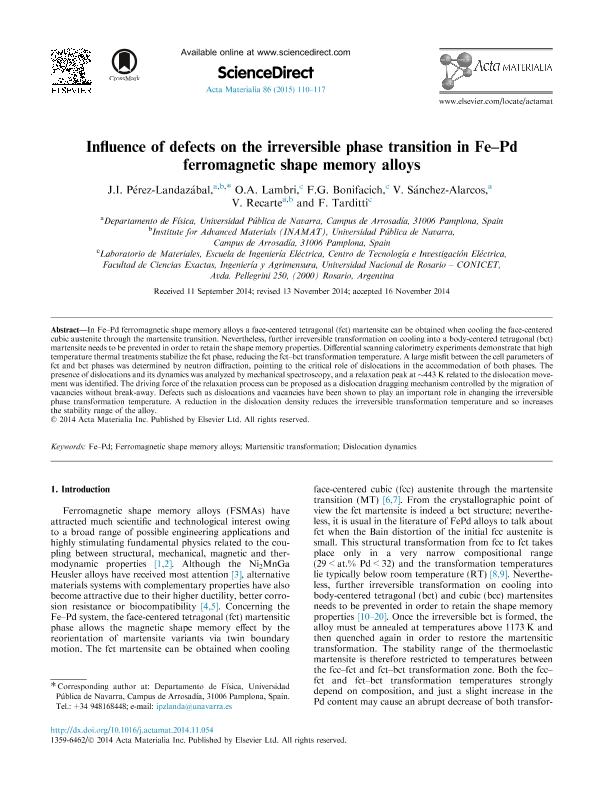Mostrar el registro sencillo del ítem
dc.contributor.author
Pérez Landazábal, J. I.
dc.contributor.author
Lambri, Osvaldo Agustin F.

dc.contributor.author
Bonifacich, Federico Guillermo

dc.contributor.author
Sánchez Alarcos, V.
dc.contributor.author
Recarte, V.
dc.contributor.author
Tarditti, Federico

dc.date.available
2018-06-25T18:23:34Z
dc.date.issued
2015-03
dc.identifier.citation
Pérez Landazábal, J. I.; Lambri, Osvaldo Agustin F.; Bonifacich, Federico Guillermo; Sánchez Alarcos, V.; Recarte, V.; et al.; Influence of defects on the irreversible phase transition in Fe-Pd ferromagnetic shape memory alloys; Pergamon-Elsevier Science Ltd; Acta Materialia; 86; 3-2015; 110-117
dc.identifier.issn
1359-6454
dc.identifier.uri
http://hdl.handle.net/11336/49966
dc.description.abstract
In Fe-Pd ferromagnetic shape memory alloys a face-centered tetragonal (fct) martensite can be obtained when cooling the face-centered cubic austenite through the martensite transition. Nevertheless, further irreversible transformation on cooling into a body-centered tetragonal (bct) martensite needs to be prevented in order to retain the shape memory properties. Differential scanning calorimetry experiments demonstrate that high temperature thermal treatments stabilize the fct phase, reducing the fct-bct transformation temperature. A large misfit between the cell parameters of fct and bct phases was determined by neutron diffraction, pointing to the critical role of dislocations in the accommodation of both phases. The presence of dislocations and its dynamics was analyzed by mechanical spectroscopy, and a relaxation peak at ∼443 K related to the dislocation movement was identified. The driving force of the relaxation process can be proposed as a dislocation dragging mechanism controlled by the migration of vacancies without break-away. Defects such as dislocations and vacancies have been shown to play an important role in changing the irreversible phase transformation temperature. A reduction in the dislocation density reduces the irreversible transformation temperature and so increases the stability range of the alloy.
dc.format
application/pdf
dc.language.iso
eng
dc.publisher
Pergamon-Elsevier Science Ltd

dc.rights
info:eu-repo/semantics/openAccess
dc.rights.uri
https://creativecommons.org/licenses/by-nc-nd/2.5/ar/
dc.subject
Dislocation Dynamics
dc.subject
Fe-Pd
dc.subject
Ferromagnetic Shape Memory Alloys
dc.subject
Martensitic Transformation
dc.subject.classification
Física Atómica, Molecular y Química

dc.subject.classification
Ciencias Físicas

dc.subject.classification
CIENCIAS NATURALES Y EXACTAS

dc.title
Influence of defects on the irreversible phase transition in Fe-Pd ferromagnetic shape memory alloys
dc.type
info:eu-repo/semantics/article
dc.type
info:ar-repo/semantics/artículo
dc.type
info:eu-repo/semantics/publishedVersion
dc.date.updated
2018-06-25T12:39:41Z
dc.journal.volume
86
dc.journal.pagination
110-117
dc.journal.pais
Estados Unidos

dc.description.fil
Fil: Pérez Landazábal, J. I.. Universidad Pública de Navarra; España
dc.description.fil
Fil: Lambri, Osvaldo Agustin F.. Universidad Nacional de Rosario. Facultad de Ciencias Exactas Ingeniería y Agrimensura. Escuela de Ingeniería Eléctrica; Argentina. Consejo Nacional de Investigaciones Científicas y Técnicas; Argentina
dc.description.fil
Fil: Bonifacich, Federico Guillermo. Universidad Nacional de Rosario. Facultad de Ciencias Exactas Ingeniería y Agrimensura. Escuela de Ingeniería Eléctrica; Argentina. Consejo Nacional de Investigaciones Científicas y Técnicas; Argentina
dc.description.fil
Fil: Sánchez Alarcos, V.. Universidad Pública de Navarra; España
dc.description.fil
Fil: Recarte, V.. Universidad Pública de Navarra; España
dc.description.fil
Fil: Tarditti, Federico. Universidad Nacional de Rosario. Facultad de Ciencias Exactas Ingeniería y Agrimensura. Escuela de Ingeniería Eléctrica; Argentina. Consejo Nacional de Investigaciones Científicas y Técnicas; Argentina
dc.journal.title
Acta Materialia

dc.relation.alternativeid
info:eu-repo/semantics/altIdentifier/doi/http://dx.doi.org/10.1016/j.actamat.2014.11.054
dc.relation.alternativeid
info:eu-repo/semantics/altIdentifier/url/https://www.sciencedirect.com/science/article/pii/S1359645414009070
Archivos asociados
